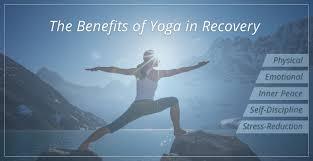I took my first yoga class at the age of 52. I had dabbled with yogic concepts during the heady days of the 1960s and did some basic postures and meditation. I even practiced Transcendental Meditation for several years.
With yoga, I found the combination of stretching, breathing, and visualization to be profoundly relaxing and soothing to my then restless mind. When I become a teacher, I found ways to share the benefits of these mental and physical exercises; first as calming techniques, and then later as ways to increase my sense of self-regulation and interpersonal awareness.
Yoga, the word translates from the Sanskrit word for "yoke," means union, pointing to the unity of mind, body, and spirit. The goal for the yoga practitioner is peace within oneself, living in harmony with the world.
I was always interested in alcohol and drug recovery and rehabilitation. So several years after I became a certified yoga instructor, I became interested in working with recovering addicts. I became a drug counselor in the hopes that I could combine yoga and recovery.
Several years after working with recovering addicts, I presented the idea of creating a yoga and meditation practice at the New Directions Program at the Wadsworth Veterans Hospital in Los Angeles. They had no such program, but the administrators thought it would be a great addition to their drug and alcohol recovery program.
Men and women come into a yoga class in various stages of recovery. Some are still going through withdrawals, some are deep in emotional denial, some are still craving, some are resistant to change, and some carry emotional scars that are worn like badges of honor.
Every yogi in recovery begins his or her practice in the present, and the present is where the power of the yogic experience resides. Then everything is possible. Everyone breathes deeply, everyone closes the eyes, everyone, empties the mind; everyone draws deep into the soul and begins his or her individual journey into consciousness; and everyone returns to the realities of their daily lives with a level of awareness that had not yet been perceived.
Although recovering addicts are still eliminating the toxins from their past drug use and still dealing with bodily cravings, those who come to yoga began to feel positive results relatively soon after the first few classes, where emphasis is on deep breathing and meditation. As my students became more acclimated to the yoga and meditation practice, I then added the physical postures, or asanas that people commonly identify with yoga practice.
How does yoga work?
A state of physical and mental relaxation provides an overall sense of tranquility, internally and externally, so that the practioner is prompted to self-integrate their mental, physical and spiritual experiences into an inclusive blueprint that strengthens their deepest senses of self. As a practitioner, the state of balance brought on by meditation often helps those in recovery to discover their own sense of compassion, optimism and joy: these are crucial tools on the way to full recovery.
It's important to emphasize the importance of integrating the various forms of yoga practice to achieve the full range of its benefits.
Breathing
Deep yogic breathing quiets the mind, reducing the incessant chatter, which produces disturbing negative thought patterns. Negative emotions can lead to depression and result in physical, chemical and behavioral addictions. And negative thought patterns can present emotional turmoil and anger, raise self-doubt, and prevent people from making healthy life decisions.
Meditation
Meditation helps us reach and experience a heightened level of consciousness. Learning to observe the various mental states, as they come and go in our conscious minds, one can achieve a kind of clarity that can facilitate our letting go of breakthrough emotions such as long-held feeling of sadness, grief, confusion and other strong emotions that a person has carried unconsciously throughout his or her life.
Postures
Of course, people come to yoga for physical fitness or better health, but the real benefit for the practioner is that the physical component of the practice often leads to an increasing sense of self-connectedness. After years of practice, some describe feelings of energy flow and subtle fields of interconnectedness between themselves and others.
No matter the state of the newborn practitioner, whether in recovery from drugs, alcohol or compulsive behavior, yoga class provides a place where there is no judgment, where every person is divine and unique, where the past is left outside the door and the future is possible.
The good news is that after I left the New Directions Program at the VA facilities, the yoga program expanded and is now flourishing bringing conscious awakening to all who embrace the practice.
Joan Moran is a keynote speaker, commanding the stage with her delightful humor, raw energy, and wealth of life experiences. She is an expert on wellness and is passionate about addressing the problems of mental inertia. A yoga instructor and an Argentine tango dancer, Joan is the author of 60, Sex, & Tango, Confessions of a Beatnik Boomer. Her new book, I'm The Boss of Me! Stay Sexy, Strong & Smart at Any Age, is now on Amazon.
Visit her website: www.joanfrancesmoran.com
Follow Joan Moran on Twitter: www.twitter.com/joanfmoran
---
Need help with substance abuse or mental health issues? In the U.S., call 800-662-HELP (4357) for the SAMHSA National Helpline.
